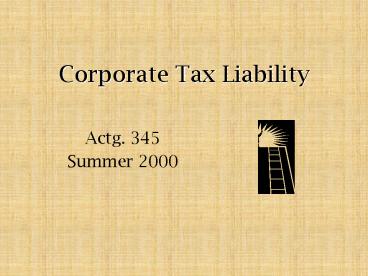Corporate Tax Liability - PowerPoint PPT Presentation
1 / 20
Title:
Corporate Tax Liability
Description:
Corporate Tax Liability. Presentation Outline. Charitable Contributions ... Charitable contributions by individuals and corporate tax- payers differ in three ways: ... – PowerPoint PPT presentation
Number of Views:113
Avg rating:3.0/5.0
Title: Corporate Tax Liability
1
Corporate Tax Liability
- Actg. 345
- Summer 2000
2
Corporate Tax Liability presented by...
- James Desalvo
- Stephen Piwnicki
- Nicole Simon
3
Corporate Tax LiabilityPresentation Outline
- Charitable Contributions
- Dividends-Received Deduction
- NOLs
- Corporate Tax Computations
- Summary
4
Corporate Tax Liabilities
Gross Income 250,000 Minus Operating
expenses ( 100,000 ) Charitable
contributions ( 7,000 ) Taxable income before
special deductions 143,000 Minus
Dividends-received deductions ( 80,000
) Taxable income 69,7777
5
Charitable Contributions
- Charitable contributions by individuals and
corporate tax- - payers differ in three ways
- Timing of the Deduction
- Deducting Contributions of Nonmonetary Property
- Maximum Deduction Permitted
6
Timing of the Deduction
- Special rule Corporations may elect to treat
part or all of a - charitable contribution as
having been made in - the year in which it was
accrued if - The board of directors authorizes the
contribution in the year - it was accrued.
- The corporation pays the contribution on or
before the fifteenth - day of the third month following the end of
the accrual year.
7
Deducting Contributions of Nonmonetary Property
- Special rule Apply to donations of appreciated
nonmonetary - property known as
- Ordinary income property - property whose sale
results in a gain - other than a long-term capital
gain. - Capital gain property- donated property that
results in long-term - capital gains.
8
Ordinary Income Property
Three special cases 1. The use of the property
is related to the donees exempt function,
and is used for the care of the ill, the needy,
or infants 2. The property is not
transferred to the donee in exchange for
money, other property, or services and 3. The
donor receives a statement from the charitable
organization stating that conditions (1) and
(2) will be complied with.
9
Capital Gain Property
- The amount of the contribution deduction
generally equals - the propertys FMV. However, special
restrictions apply if - The use of the property is unrelated to
tax-exempt purpose or - A corporation donates appreciated property to
certain private - nonoperating foundations.
10
Maximum Deduction Permitted
Adjusted taxable income is the corporations
taxable income computed with out regard to any of
the following 1. The charitable contribution
deduction 2. An NOL carryback 3. Any
dividends-received deduction
11
Dividends-Received Deduction
- Rules
- Own less than 20, allowed a 70 deduction.
- Own 20 or more, but 80 or less, allowed a 80
deduction. - Own more than 80, allowed a 100 deduction.
12
Dividends-Received Deduction
- Steps
- 1. Determine deduction percentage allowed
- 2. Multiply percentage by taxable income (A)
- 3. Multiply percentage by dividends received (B)
- 4. Take the lesser of A or B.
13
Dividends-Received Deduction
- Exception to the Rule
- Determine taxable income.
- Subtract the dividends-received deduction
allowed. - If the result is a Net Operating Loss, then
deduct the full amount allowed.
14
Dividends-Received Deduction
- Debt Financed Stock
- If receive dividends on financed stock, no
deduction is allowed. - Tax savings on dividends-received deduction and
on interest paid to finance the purchase.
15
Example
- JNS Corporation reported income of 700,000 in
2000. Their total related expenses were
715,000. JNS Corporation had a charitable
contribution of 80,000 and received a dividend
for 90,000 from ABC Corporation, of which they
have a 35 interest in. What is the
Dividends-Received Deduction allowed? Taxable
Income before the charitable contribution or
dividend received equals 75,000. Taxable Income
after charitable contribution is 67,500. The
dividends-received deduction for 2000 is 72,000.
16
Net Operating Losses (NOLs)
- The amount by which the corporations deductions
(including any dividends-received deduction)
exceed gross income. - Carries back 2 years and forward 20 years.
17
NOLs Example (C3-18)
- In 2000 Gary Corporation has gross income of
150,000 (including 100,000 from operations and
50,000 in dividends from a 30 - owned domestic
corporation) and 180,000 of expenses. Gary has
a 70,000 150,000 - 180,000 - (.8 X 50,0000)
NOL. The loss carries back to 1998 unless Gary
elects to relinquish the carryback periods. If
Gary had 20,000 of taxable income in 1998,
20,000 of Garys 2000 NOL offsets that income.
Gary receives a refund of all taxes paid in 1998.
Gary carries the remaining 50,000 of NOL from
1998 to 1999.
18
NOLsSequence of Deductions
- All deductions
- Charitable contributions deduction
- Dividends - received deduction
- NOL deductions
19
Computing a Corporations Income Tax
Liability
Ex.) XYZ corporations taxable income for the
years 2000, and 2001are as follows 2000 200
1 Taxable income 90,000 200,000 The
following is the computations for XYZ
corporations regular tax liability
2000
2001 Tax on First 50,000
.15 X 50,000 7,500
7,500 Tax on Second 25,000
.25 X 25,000 6,250
6,250 Tax on remaining (15,000
125,000) 5,100 42,500
.34 X 15,000 5,100 .34 X 125,000 42,500
Surcharge (.05 X 100,000 5,000) 0
5,000 Regular Tax Liability
16,450 61,250 If taxable income
exceeds 100,000, a 5 surcharge applies
20
Summary
- Determine the allowed deductions.
- Follow the deduction sequence.
- Compute taxable income.
- Apply the corporate tax rate.































